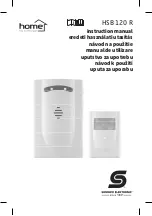
-5-
This test mode will automatically cancel in
five minutes. Alternatively to cancel the ‘RF’
continuity test - press and hold the program
button until the LED lights then release.
If it is necessary to conduct a site survey prior
to installation of this equipment it is advisable
to power the RFX-3 Receiver temporarily with
a PP3 (9 volt) battery. Register one detector,
then conduct and RF continuity test as detailed
above. As the signals to the receiver are sent
once per seconds the optimum position of both
the Opal RFX and the RFX-3 Receiver can be
easily established.
CHANGING THE RANDOM CODE
In the unlikely event of another radio signal
affecting the correct operation of a single
channel. The Opal RFX detector can generate
an alternative random code.
Press the program button on the Opal RFX
nine times. On the ninth press ‘hold’ the button
down for 5 seconds until the LED goes out, then
release the button.
Then erase the code form the RFX-3 Reciever
byt holding down that ‘channel button’ until the
beeps stop, then repeat steps ‘2’ to ‘6’ of the
‘Setup’ procedure to register the new code.
OPAL RFX INSTALLATION
During installation the electronics must be
protected against water, as trapped moister can
effect or damage the unit.
1. First remove the front polythene cover by
pulling forwards, then remove the lense
module by pulling it out of the forked bracket.
2. Drill the wall to accept the fixing screw
supplied with the wall plug.
3.Fit the housing to a secure surface. When the
surface is uneven use the 4mm spacer
supplied to ensure that the radio signals
transmitted achieve their optimum distance.
4. Always ensure when replacing the module
that it is the correct way up for the correct
alignment of the beam pattern (see page 7
multibeam lens data)
TESTING THE OUTPUTS
(Alignment of the detection beams)
The range of the detector increase without
the front protective cover. Therefore the
front cover must be fitted to establish the
correct beam pattern alignment and when
testing outputs.
When the ‘program’ button is pressed
momentarily the red indicator lights and pulse
count ‘1’ is automatically selected. The unit can
then be alighned. The red indicator will light
on the Opal RFX and the respective Channel
indicator will flash every tme a detection takes
place. This test mode will automatically cancel
five minutes after last detection. Alternatively , to
cancel this ‘walk test mode’ press the program
button twice.
ALIGNMENT
Passive infrared movement sensors detect
the temperature changes of moving objects.
Movement across the beams produces the
best response and range whilst movement
towards the detector would be less responsive.
Us the pan and tilt facility to accurately target
the detection zone, and adjust the range of the
detector to cover the required area.
The clear mask supplied with the detector can
be cut and applied vertically or horizontally
to eliminate coverage of a single beam, and
entire long range section or corridor beam for
CCTV applications. When mounting higher
than boundary fences mask off any side beams
that fall outside of the required detection area.
Also ensuring that no obstacles, such as walls
or large trees for examples, obstruct the beam
pattern view.
As the unit detects a change in heat in its field
of view, therefore to avoid any false alarms,
direct sunshine, trees, shrubs, ponds, central
heating boiler flues and animals should all be
considered when sighting the detector. The
unit is not recommended for mounting on metal
clad buildings in direct sun as excessive heat
produces haze ripply which can produce false
activations.

























